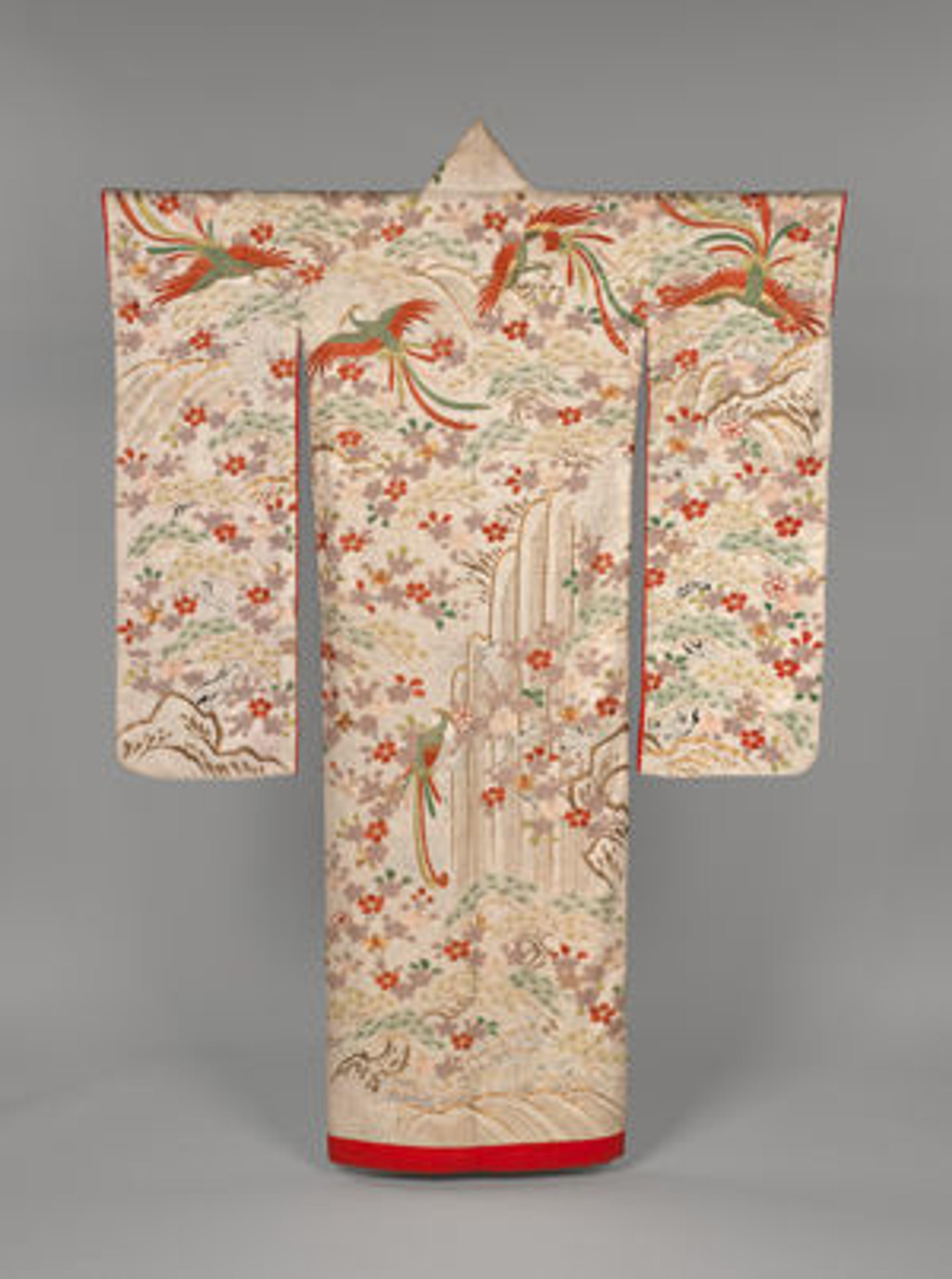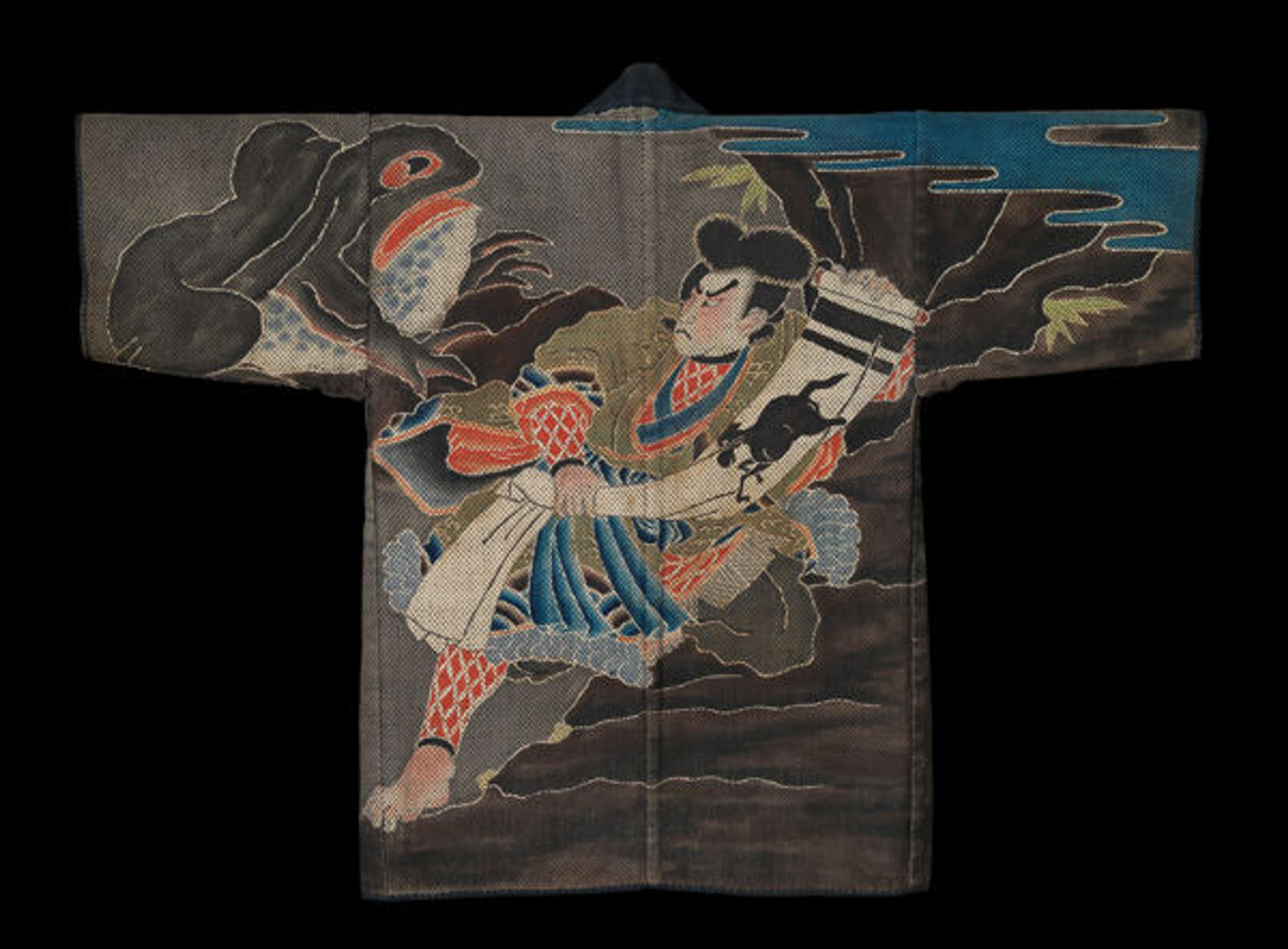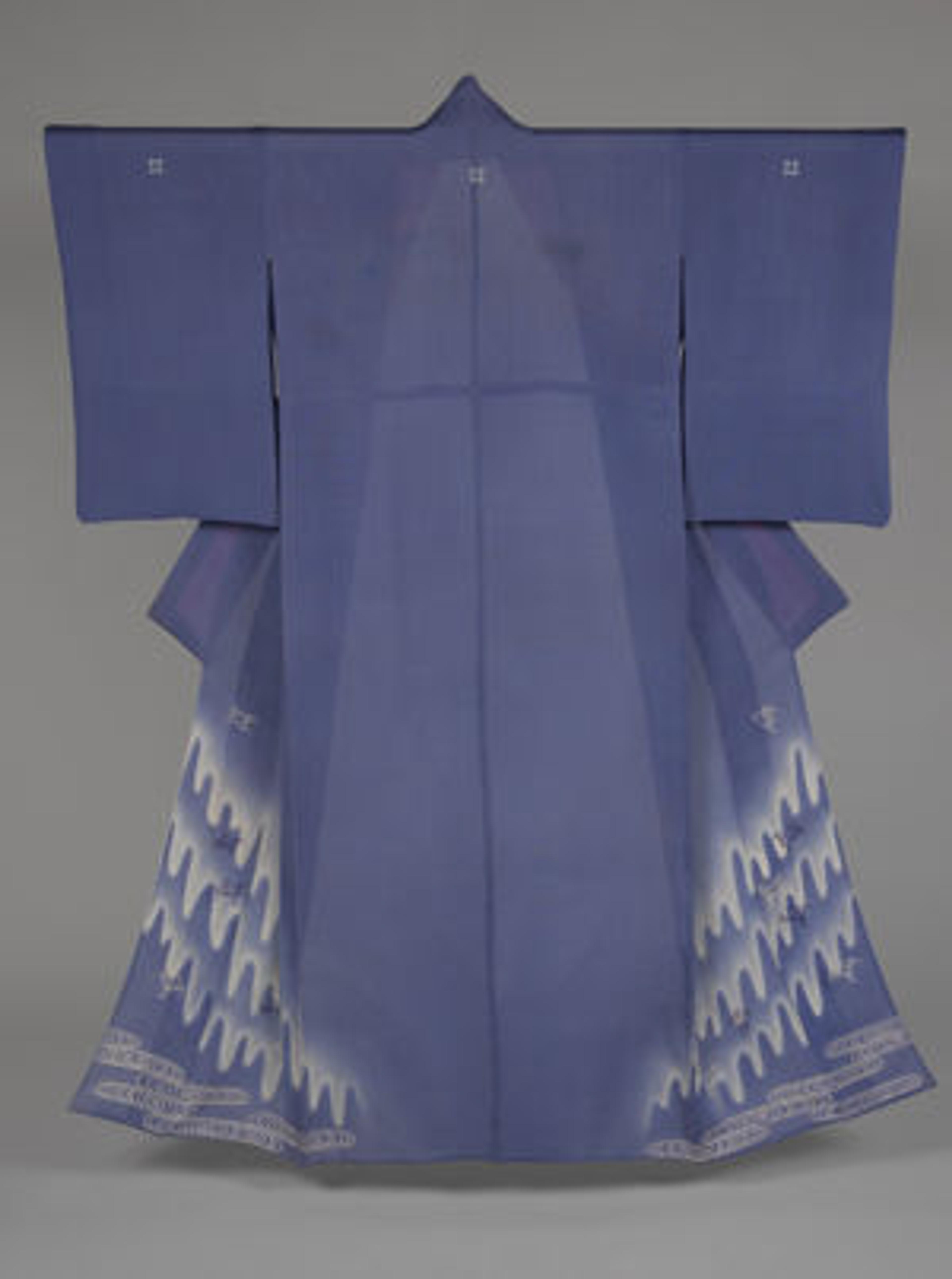Waves, Waterfalls, and Whirling Water on Japanese Kimono
«The way that kimonos are used and the types of designs to decorate them have shifted dramatically over the last 150 years, shaped by the dialogue of Japanese traditional craft art with modern inventions and Western ideas. As shown in a selection of objects currently found in the exhibition Kimono: A Modern History, on view through January 19, 2015, we can follow this narrative of cultural interaction by focusing on the depiction of water motifs used on kimono.»
During the Edo period (1615–1868) one's manner of dressing in public immediately revealed social status. The formal over robes for samurai- and merchant-class ladies worn untied over the kimono were often embellished with auspicious symbols—especially those designed for a wedding. Birds with long tails inhabit a bright landscape of waterfalls, rocks, pine trees, and cherry blossoms on this over robe; most brilliant of all is the gold thread of the waterfalls.

Left: Over Robe (Uchikake) with Long-Tailed Birds in a Landscape, second half of the 18th century. Japan, Edo period (1615–1868). Silk and metallic-thread embroidery and paste-resist dyeing on silk satin damask. The Metropolitan Museum of Art, New York, Gift of Charles Zadok, 1959 (59.46)
The wooden architecture and crowded living conditions in the urban areas of late Edo and Meiji period (1868–1912) Japan led to frequent fires. Firefighter's coats were made of several layers of thick, quilted cotton fabric. The inside of these jackets are decorated with colorful designs, often inspired by popular contemporary woodblock prints, which mainly depicted warrior heroes and mythical creatures that instill bravery or are related to water. The coats were soaked in water and worn plain-side out when fighting fires, but inside-out after putting out a fire or during festivals. The wizard Jiraiya is known for his ability to morph into a giant toad, and below he is depicted encountering a toad that he has summoned using his scroll.

Fireman's Jacket with the Wizard Jiraiya Turning into a Giant Toad, early 20th century. Japan, Meiji period (1868–1912). Quilted cotton with paste relief. Lent by John C. Weber Collection
During the Taishō period (1912–26), Japanese society enjoyed relative prosperity and more relaxed social mores, while continued rapid modernization brought changes in domestic life and gave rise to urban consumer culture. The so-called "Taishō romantic" (Taishō roman) aesthetic—which merged novel Western and traditional Japanese motifs in bold, colorful designs—came to represent the mainstream taste of the time. Women, especially in big cities, gradually entered the work force, and the elegant, modern woman, or "modern girl" (moga), was often portrayed in art and literature. Unlined, light and airy summer kimonos were often decorated with motifs that instilled a cooling psychological effect. At left, violet and white plovers wheel and dive on a background of abstract peaked shapes that may be meant to represent waves, or the drying fishnets found along the shores where plovers were plentiful.

Left: Unlined Summer Kimono (Hito-e) with Plovers in Flight over Stylized Waves. Japan, Taishō period (1912–26). Embroidered and dye-patterned silk gauze (ro). The Metropolitan Museum of Art, New York, Gift of Atsuko Irie, in honor of Suga Irie, 1998 (1998.487.5)
Abstract and graphic designs, some of them inspired by the Art Nouveau or Art Deco styles, became fashionable in the Shōwa period (1926–89). The designer of the swirl-decorated kimono created stylized, spiral-like shapes reflecting the contemporary Art Deco aesthetic. On the other summer kimono, groups of blue and red dragonflies flutter against a light beige ground adorned with lavender swirling streams. Dragonflies evoke the evanescent and fleeting nature of the seasons as well as the passage of time, from summer to autumn.

Left: Unlined Summer Kimono (Hito-e) with Swirls, ca. 1920–30. Japan, Taishō (1912–26) or Shōwa period (1926–89). Crepe silk gauze (ro). Lent by John C. Weber Collection. Right: Unlined Summer Kimono (Hito-e) with Dragonflies and Stream, ca. 1920–30s. Japan, Shōwa period (1926–89). Printed silk. Lent by Julia Meech Collection
Meisen kimonos became popular for everyday wear during the first half of the twentieth century, because meisen fabric, woven from predyed yarn, was both inexpensive and long-lasting. These garments were mass-produced from plain-weave raw silk, and later rayon, mainly in regions north of Tokyo. These kimonos were marketed in department stores and people expected new designs every season. They are often decorated with large geometric patterns, usually in vivid colors. The design of the playful meisen kimono shown at left refers to colorful soap bubbles or water drops, or may be simply a creative combination of circles.

Left: Meisen Kimono with Overlapping Circular Patterns, first half of the 20th century. Japan, Taishō (1912–26) or Shōwa period (1926–89). Raw silk, stencil-dyed warps and wefts. Lent by John C. Weber Collection.

During the Meiji period (1868–1912), as industrialization and modernization threatened the survival of traditional arts and craftsmanship, the Japanese government realized the necessity of documenting and preserving Japanese arts. From 1955 certain artists were honored as "Living National Treasures." Moriguchi Kunihiko, designated a Living National Treasure in 2007, followed in the footsteps of his father, Moriguchi Kakō, and became the first father and son to receive this title during their lifetimes. The design on the kimono shown at left is Kunihiko's unique interpretation of the flowing water, or waterfall, pattern. He applied the maki-nori ("sprinkled rice paste") yūzen dyeing (paste-resist) technique developed by his father to express the dramatic curves of the water, thus transforming the design into a modern and abstract graphic composition.
Left: Moriguchi Kunihiko (Japanese, b. 1941). Kimono with Flowing Water Design, 1992. Japan, Heisei period (1989–present). Paste-resist dyed (yūzen) crepe silk. The Metropolitan Museum of Art, New York, Purchase, Sue Cassidy Clark Gift, in memory of Terry Satsuki Milhaupt, 2014 (2014.521) © Moriguchi Kunihiko
Monika Bincsik
Monika Bincsik is an assistant curator in the Department of Asian Art.